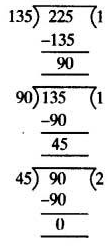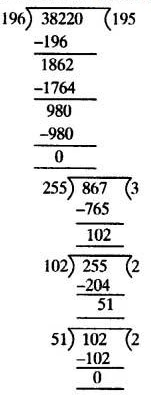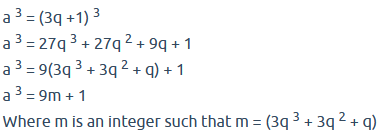NCERT solutions for class-10 maths chapter 1 Real Numbers is prepared by academic team of Physics Wallah. we have prepared solutions for all exercises of this chapter. Given below is step by step NCERT solutions of all questions given in NCERT textbook for chapter 1. You have learned the formula of the given chapter. Physics Wallah prepared a detail notes and additional questions for class-10 maths with short notes of all maths formula of class-10 maths. Also read theory before moving to solve the exercise of NCERT chapter 1.
1. Use Euclid’s division algorithm to find the HCF of:
(i) 135 and 225
(ii) 196 and 38220
(iii) 867 and 255
Answer:
(i) 135 and 225
Since 225 > 135, we apply the division lemma to 225 and 135 to obtain
225 = 135 × 1 + 90
Since remainder 90 ≠ 0, we apply the division lemma to 135 and 90 to obtain
135 = 90 × 1 + 45
We consider the new divisor 90 and new remainder 45, and apply the division lemma to obtain
90 = 2 × 45 + 0
Since the remainder is zero, the process stops.
Since the divisor at this stage is 45,
Therefore, the HCF of 135 and 225 is 45.

(ii) 196 and 38220
Since 38220 > 196, we apply the division lemma to 38220 and 196 to obtain
38220 = 196 × 195 + 0
Since the remainder is zero, the process stops.
Since the divisor at this stage is 196,
Therefore, HCF of 196 and 38220 is 196.

(iii) 867 and 255
Since 867 > 255, we apply the division lemma to 867 and 255 to obtain
867 = 255 × 3 + 102
Since remainder 102 ≠ 0, we apply the division lemma to 255 and 102 to obtain
255 = 102 × 2 + 51
We consider the new divisor 102 and new remainder 51, and apply the division lemma to obtain
102 = 51 × 2 + 0
Since the remainder is zero, the process stops.
Since the divisor at this stage is 51, Therefore, HCF of 867 and 255 is 51.
2. Show that any positive odd integer is of the form 6q + 1, or 6q + 3, or 6q + 5, where q is some integer.
Answer:
Let a be a given integer.
On dividing a by 6 , we get q as the quotient and r as the remainder such that,
a = 6q + r, r = 0,1,2,3,4,5
when r =0
a = 6q,even no
where r = 1
a = 6q + 1, odd no
where r = 2
a = 6q + 2, even no
where r = 3
a=6q + 3,odd no
where r = 4
a = 6q + 4, even no
where r = 5
a = 6q + 5, odd no
where r = 6
Therefore, 6q + 1, 6q + 3, 6q + 5 are not exactly divisible by 2. Hence, these expressions of numbers are odd numbers.
And therefore, any odd integer can be expressed in the form 6q + 1, or 6q + 3,or 6q + 5
3. An army contingent of 616 members is to march behind an army band of 32 members in a parade. The two groups are to march in the same number of columns. What is the maximum number of columns in which they can march?
Answer:
For the above problem, the maximum number of coulmns would be the HCF of 616 and 32
We can find the HCF of 616 and 32 by using Euclid Division algorithm.
Therefore
616 = 19 x 32 + 8
32 = 4 x 8 + 0
8 = 8 x 1 + 0
Therefore HCF (616, 32) = HCF of (32, 8) = 8
Therefore the maximum number of columns in which they can march is 8.
4. Use Euclid’s division lemma to show that the square of any positive integer is either of form 3m or 3m + 1 for some integer m. [Hint: Let x be any positive integer then it is of the form 3q, 3q + 1 or 3q + 2. Now square each of these and show that they can be rewritten in the form 3m or 3m + 1.
Answer:
If a and b are two positive integers, then,

Therefore, r = 0, 1, 2
Therefore, a = 3q or a = 3q + 1 or a = 3q + 2

Therefore, the square of any positive integer is either of the form 3m or 3m + 1.
5. Use Euclid’s division lemma to show that the cube of any positive integer is of the form 9m, 9m + 1 or 9m + 8.
Answer:
Let a be any positive integer and b = 3
a = 3q + r, where q ≥ 0 and 0 ≤ r < 3
Therefore, every number can be represented as these three forms. There are three cases.
Case 1: When a = 3q,
Where m is an integer such that m = (3q) 3
Case 2: When a = 3q + 1,

Case 3: When a = 3q + 2,

Therefore, the cube of any positive integer is of the form 9m, 9m + 1, or 9m + 8.
